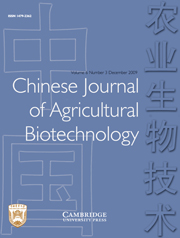No CrossRef data available.
Article contents
Cloning, expression and bioactivity of chicken receptor activator of NF-κB ligand (chRANKL)
Published online by Cambridge University Press: 03 March 2009
Abstract
Using reverse transcription polymerase chain reaction (RT-PCR) and gene splicing by overlap extension (SOE-PCR), the DNA sequence encoding the chicken receptor activator of NF-κB ligand (RANKL) was amplified, cloned into the expressing plasmid pET-32a(+) with His-tag, and highly expressed in Escherichia coli. The purified protein was then added to primary cultures of chicken osteoclasts to observe its bioactivity. The results showed that the size of the PCR product was 1200 bp, which was consistent with the expected size, and the relative molecular weight of the induced protein was 64 kDa. Western blotting indicated that induced protein could react with anti-His antibody. It was also found that the induced protein can stimulate mature chicken osteoclasts to resorb bone.
Information
- Type
- Research Papers
- Information
- Copyright
- Copyright © China Agricultural University 2008
Footnotes
First published in Journal of Agricultural Biotechnology 2008, 16(1): 32–36

